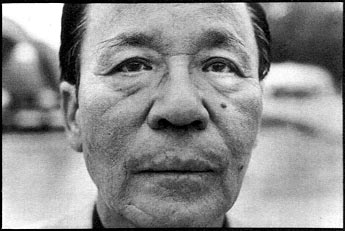Yoshito Matsushige was a Hiroshima survivor and the only photographer who was able capture an immediate, first-hand photographic historical account of the destruction of the atomic bombing of Hiroshima. In 1941, he had joined Geibinichinichi Newspaper Corporation, which later merged with the Chugoku Shimbun Company. He was assigned to the photography department and after 1944, he also worked as a press report group member at Chugoku Regional Military Headquarters.
Photographing Hiroshima
On August 6, 1945, Yoshito Matsushige was 32 years old, living at home in Midori-cho, Hiroshima. His home was 1.7 miles away from ground zero, just outside of the 1.5 mile radius of the total destruction created by atomic blast effects. Miraculously, Matsushige was not seriously injured by the explosion. With one camera and two rolls of film with 24 possible exposures, he tried to photograph the immediate aftereffects of the bombing of Hiroshima.
Blocked by flames, Matsushige was unable to get to his newspaper office so he returned to Miyuki Bridge. In his account of the experience, he explains how he tried to take photographs of the terrible carnage he witnessed at the bridge but could not bring himself to press the shutter button. After struggling at that location for twenty minutes, he finally took his first photographs. During the next ten hours, Matsushige was only able to click the shutter seven times. He said, “It was such a cruel sight that I couldn’t bring myself to press the shutter.” In addition, he was afraid the burned and battered people would be enraged if someone took their pictures. Matsushige could not develop the film right away but eventually did so after twenty days, in the open, at night, using a radioactive stream to rinse the photographs. Only five of the seven photographs were developable. His photos would be the only immediate record of the destruction at Hiroshima.
A few weeks after the atomic bombing, the American military confiscated all of the post-bombing newspaper photographs and/or newsreel footage, but failed to confiscate many of the negatives. As a result, photographs from the Hiroshima atomic bombing were not published until the United States occupation of Japan ended in April 1952. The magazine Asahi Gurafu initially published Matsushige’s photographs in a special edition on August 6, 1952. This edition was titled “First Exposé of A-Bomb Damage.” This special edition sold out so quickly that four additional printings were run, replacing the original color cover with a black and white one. The total circulation of this special edition was approximately 700,000. The following month, Life Magazine published two of the five Matsushige’s photographs in the September 29, 1952 edition of the magazine in an article titled “When Atom Bomb Struck – Uncensored.”
Later Years
In 1969, Matsushige retired from the Chugoku Shimbun and became a dedicated peace activist. He communicated his experience of witnessing the destruction and horrors of the atomic bombing of Hiroshima through a series of photo essays and publishing several books. He gave speeches in Japan and abroad, including the United Nations General Assembly.
In 1978, Matsushige, together with others who took photographs of the atomic bombing, formed the Association of Photographers of the Atomic (Bomb) Destruction of Hiroshima. This organization included the families of those atomic bomb photographers who had passed away since 1945. Matsushige dedicated most of his life to the organization and preservation of the photo history of the atomic bombing of Hiroshima.
Biography and photos are courtesy of David Wargowski of the Atomic Photographers Guild.





